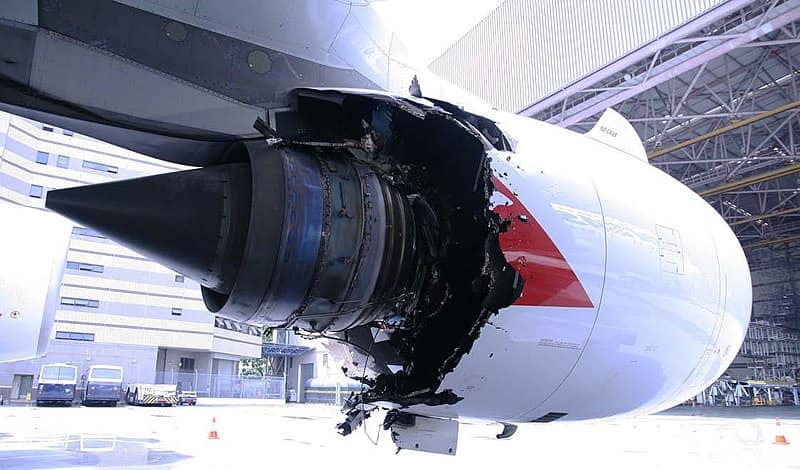Incident:
The plane took off on runway 20C at Changi Airport at 9:56am. Following a normal takeoff, the flaps and landing gear were retracted. The plane was climbing through 7,000 feet and flying over Batam Island at 250 knots, the #2 engine exploded. Numerous alarms were sounding in the cockpit and the ECAMS were indicating numerous of unrelated failures. The plane of the #2 had punctured the wing, causing the fuel to leak. Shortly after the explosion, Captain Richard Champion de Crespigny took controls while First Officer Matt Hicks monitors the failures. There were also a second officer and 2 check captains in the cockpit. As the pilots turned left back to Singapore, they decided to shut down the damaged engine but the engine was already on fire. Shrapnel from the damaged engine had also disabled one hydraulic system and the anti-lock braking system, causes the #1 and #4 engines to go into a degraded mode.
The plane had damaged the left wing flaps and controls of the outboard left engine as well. Once the crew found out that the plane is still controllable, they decided to fly in a holding pattern close to Changi Airport. It took almost an hour to complete the situation. First Officer Hicks and Supervising Check Captain David Evans then input the plane’s status to the landing distance performance application for a landing 50 tonnes over the maximum landing weight. They also found out that due to the damage, dumping fuel was impossible. They then confirm that the landing speed was 146 knots. But afraid that the plane will stall while reaching that speed, the captain added 20 knots. As the Singapore cleared the A380 for a long 20 mile approach to runway 20C. The group then, at that point, brought down the arrival gear by a gravity drop crisis augmentation framework and the folds. During the methodology, Crisping observed the plane’s velocity with the goal that the plane wouldn’t slow down on approach. At 11:35am, the A380 made a protected crisis arriving at Changi Airport. Not long after handling, the pilots had fostered an issue. They couldn’t close down the #1 motor, which must be soaked by crisis fire teams until flameout was accomplished. They additionally had another issue, the fuel was all the while spilling from the left wing and onto the brakes, which was very hot from most extreme slowing down. The pilots settled on a choice to not begin the departure right now. The A380 was on battery power and needed to battle with just a single VHF radio to arrange crisis system with the neighborhood fire group. Minutes after the fact, the team gave the consent for the travelers to clear the plane yet were as yet incapable to close down the #1 motor. It took the firemen 2 hours to close down the motor. Every one of the 469 individuals on board were securely on the ground.
Investigation:
The agents from the Australian Transport Safety Bureau demonstrated a weariness breaking in the stub pipe inside the motor brought about the oil spillage followed by an oil fire in the motor. The fire prompted the arrival of the Intermediate Pressure Turbine circle. The motor’s maker Rolls-Royce discovered that the immediate reason was a skewed counter drag inside the stub oil pipe prompting an exhaustion break, in which the ATSB report affirms Rolls-Royce’s discoveries. The plane included was fixed and gotten back to support in April 2012.


